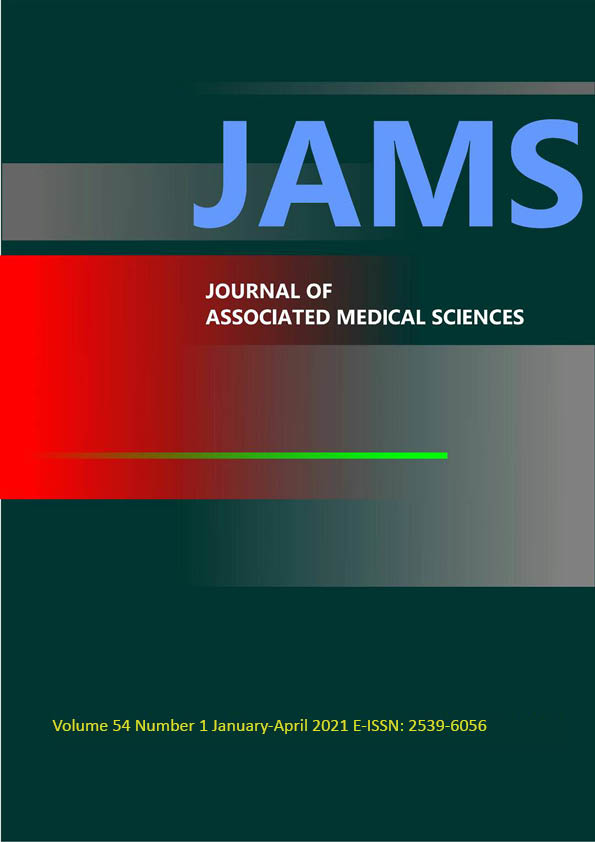Analysis of patient radiation dose and angiographic techniques during intracranial aneurysmal diagnosis: a 5-year experience of interventional neuroradiology unit in Srinagarind Hospital.
Main Article Content
Abstract
Background: Intracranial aneurysmal diagnosis (IAD) with an angiographic procedure is the gold standard diagnosis that provides more benefit than other techniques. Moreover, IAD has been the most common diagnostic procedure in the Interventional Neuroradiology unit (INR) in Srinagarind Hospital. However, the angiographic techniques and radiation dose from IAD had never been determined. Therefore, a review of the IAD procedure was considered.
Objectives: This study was set up to obtain a baseline data of IAD radiation dose and angiographic techniques, to compare the radiation dose and angiographic techniques during 5 years of experience and to set up the local DRLs for IAD.
Materials and methods: A retrospective study from January 2014 to December 2018 of IAD patients using bi-plane digital subtraction angiography (DSA) was conducted. Patient’s data was reviewed as follows: age, gender, cerebral angiography techniques including kV, mAs, acquisition time of 2-dimensional angiography (2DA) and 3-dimensional rotational angiography (3DRA), total number of angiographic frames, fluoroscopic time, number of 2DA exposure, number of 3DRA exposure, and radiation dose (dose area product; DAP in µGy.m2 and air kerma; Kar in mGy).
Results: A total of 795 cases (338 male and 457 female), including adult and pediatric patients at the age of 1-91 years old, were recruited into this study. The results showed significant differences in radiation dose, kV, mAs, number of 2DA exposures, 2DA acquisition time, fluoroscopic time, and angiographic frames (p<0.05) throughout 5 years. The 3rd quartile of DAP and Kar have significantly increased from 15,636.30 µGy.m2 and 939.70 mGy in 2014 to 20,006.36 µGy.m2 and 1,050.53 mGy in 2018 (p<0.001), respectively. The pediatric DAP and Kar (16,375.54 µGy.m2 and 816.70 mGy) are slightly lower than the total patient’s dose.
Conclusion: Alteration of angiographic techniques during IAD procedure over 5 years might mainly contribute to factors influencing the elevation of radiation dose. The DRLs of IAD procedure in this study is much higher than in other studies. The finding of strategies to reduce radiation dose, particularly pediatric radiation dose, must be further performed.
Article Details

This work is licensed under a Creative Commons Attribution-NonCommercial-NoDerivatives 4.0 International License.
Personal views expressed by the contributors in their articles are not necessarily those of the Journal of Associated Medical Sciences, Faculty of Associated Medical Sciences, Chiang Mai University.
References
Hacein-Bey L, Provenzale JM. Current imaging assessment and treatment of intracranial aneurysms. AJR Am J Roentgenol 2011; 196(1): 32-44.
Manninen AL, Isokangas JM, Karttunen A, Siniluoto T, Nieminen MT. A comparison of radiation exposure between diagnostic CTA and DSA examinations of cerebral and cervicocerebral vessels. AJNR Am J Neuroradiol 2012; 33(11): 2038-42.
Mooney RB, McKinstry CS, Kamel HA. Absorbed dose and deterministic effects to patients from interventional neuroradiology. Br J Radiol 2000; 73(871): 745-51.
Balter S, Miller DL. Patient skin reactions from interventional fluoroscopy procedures. AJR Am J Roentgenol 2014; 202(4): 335-42.
Miller DL, Balter S, Dixon RG, Nikolic B, Bartal G, Cardella JF, et al. Quality improvement guidelines for recording patient radiation dose in the medical record for fluoroscopically guided procedures. J Vasc Interv Radiol 2012; 23: 11-18.
Morris PP, Geer CP, Singh J, Brinjikji W, Carter RE. Radiation dose reduction in neuroendovascular procedures. World Neurosurg 2013; 80: 681-2.
Yi HJ, Sung JH, Lee DH, Kim SW, Lee SW. Analysis of Radiation Doses and Dose Reduction Strategies During Cerebral Digital Subtraction Angiography. World Neurosurg 2017; 100: 216‐23.
Pearl MS, Torok C, Wang J, Wyse E, Mahesh M, Gailloud P. Practical techniques for reducing radiation exposure during cerebral angiography procedures. Journal of NeuroInterventional Surgery 2015; 7: 141-5.
Morris PP, Geer CP, Singh J, Brinjikji W, Carter RE. Radiation dose reduction during neuroendovascular procedures. J Neurointerv Surg 2018; 10: 481-6.
Ihn YK, Kim BS, Byun JS, Suh SH, Won YD, Lee DH, et al. Patient Radiation Exposure During Diagnostic and Therapeutic Procedures for Intracranial Aneurysms: A Multicenter Study. Neurointervention 2016; 11(2): 78‐85.
Aroua A, Rickli H, Stauffer JC, Schnyder P, Trueb PR, Valley JF, et al. How to set up and apply reference levels in fluoroscopy at a national level. Eur Radiol 2007; 17: 1621-33.
Chun CW, Kim BS, Lee CH, Ihn YK, Shin YS. Patient radiation dose in diagnostic and interventional procedures for intracranial aneurysms: experience at a single center. Korean J Radiol 2014; 15: 844-9.
D'Ercole L, Thyrion FZ, Bocchiola M, Mantovani L, Klersy C. Proposed local diagnostic reference levels in angiography and interventional neuroradiology and a preliminary analysis according to the complexity of the procedures. Phys Med 2012; 28(1): 61‐70.
Brambilla M, Marano G, Dominietto M, Cotroneo AR, CarrieroA. Patient radiation doses and references levels in interventional radiology. Radiol Med 2004; 107: 408-18.
Schneider T, Wyse E, Pearl MS. Analysis of radiation doses incurred during diagnostic cerebral angiography after the implementation of dose reduction strategies. J Neurointerv Surg 2017; 9(4): 384-8.
Rerksoontree T, Munkong W,Somboonnithiphol K, Takong W. Epidermiology and trends of neurovascular disease, in Northeast of Thailand; Angiographic base [Diploma of Thai Board of Diagnostic Radiology of The Medical Council of Thailand 2018]. KhonKaen: Faculty of Medicine, KhonKaen University; 2018.
Jersey AM, Foster DM. Cerebral Aneurysm. [Updated 2020 Jun 30]. In: StatPearls [Internet]. Treasure Island (FL): StatPearls Publishing; 2020 Jan.
Dance DR, Christofides S, Maidment ADA, McLean ID, Ng KH, editors. Diagnostic Radiology Physics A Handbook for Teachers and Students. Vienna: International Atomic Energy Agency, Vienna International Centre; 2014.
Allen E, Hogg P, Ma W, Szczepura K. Fact or fiction: An analysis of the 10 kVp ‘rule’ in computed radiography. Radiography 2013: 19; 223-27.
Kahn EN, Gemmete JJ, Chaudhary N, Gregory T, Chen K, Christodoulou EG, et al. Radiation dose reduction during neurointerventional procedures by modification of default settings on biplane angiography equipment. J Neurointerv Surg 2016; 8(8): 819-23.


